child lock MAZDA MODEL 6 2014 Owners Manual (in English)
[x] Cancel search | Manufacturer: MAZDA, Model Year: 2014, Model line: MODEL 6, Model: MAZDA MODEL 6 2014Pages: 576, PDF Size: 8.58 MB
Page 11 of 576
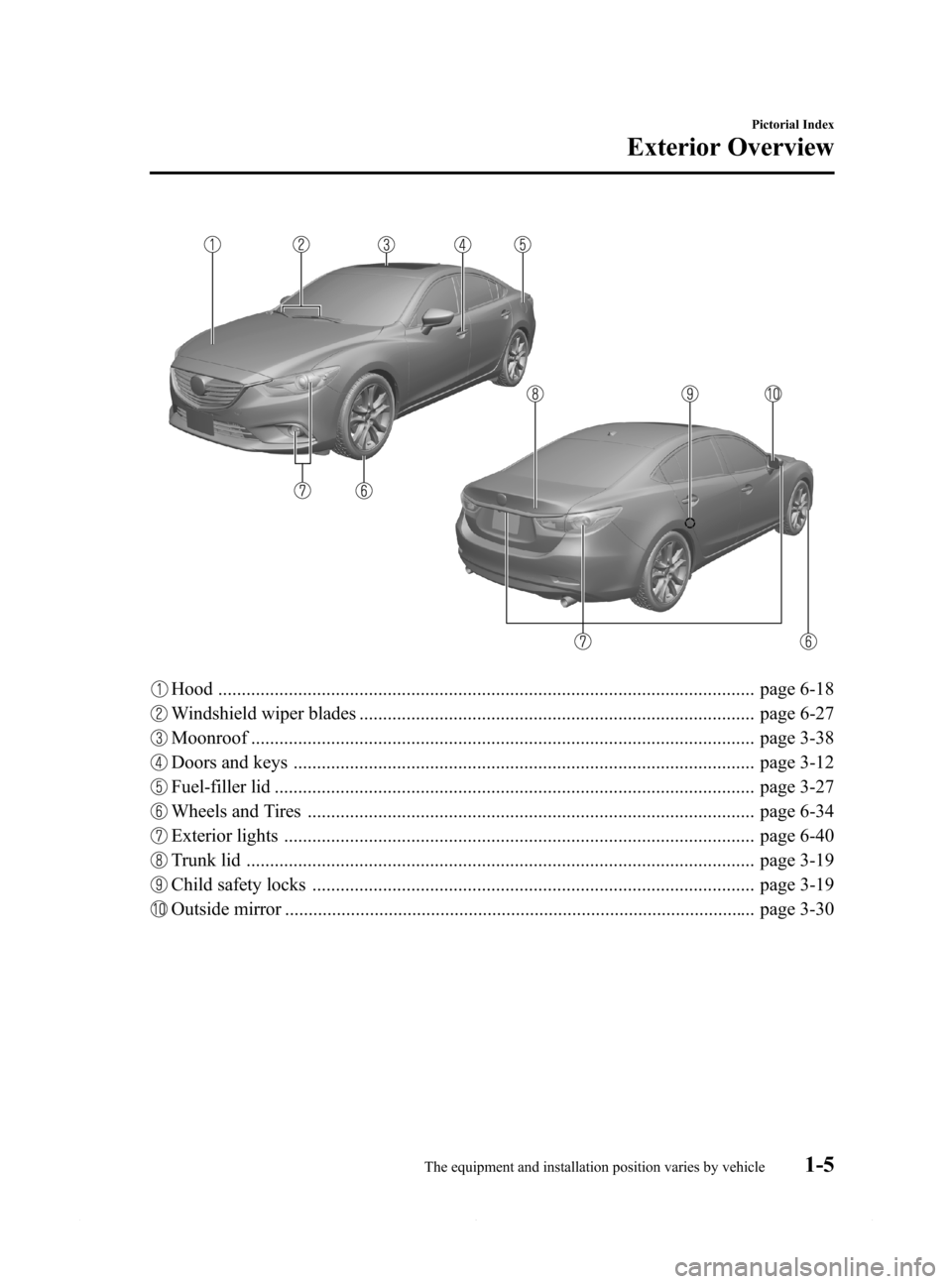
Black plate (11,1)
Hood .................................................................................................................. page 6-18
Windshield wiper blades .................................................................................... page 6-27
Moonroof ........................................................................................................... page 3-38
Doors and keys .................................................................................................. page 3-12
Fuel-filler lid ...................................................................................................... page 3-27
Wheels and Tires ............................................................................................... page 6-34
Exterior lights .................................................................................................... page 6-40
Trunk lid ............................................................................................................ page 3-19
Child safety locks .............................................................................................. page 3-19
Outside mirror .................................................................................................... page 3-30
Pictorial Index
Exterior Overview
1-5The equipment and installation position varies by vehicle Mazda6_8DQ8-EA-13L_Edition3 Page11
Friday, June 13 2014 6:20 PM
Form No.8DQ8-EA-13L
Page 14 of 576
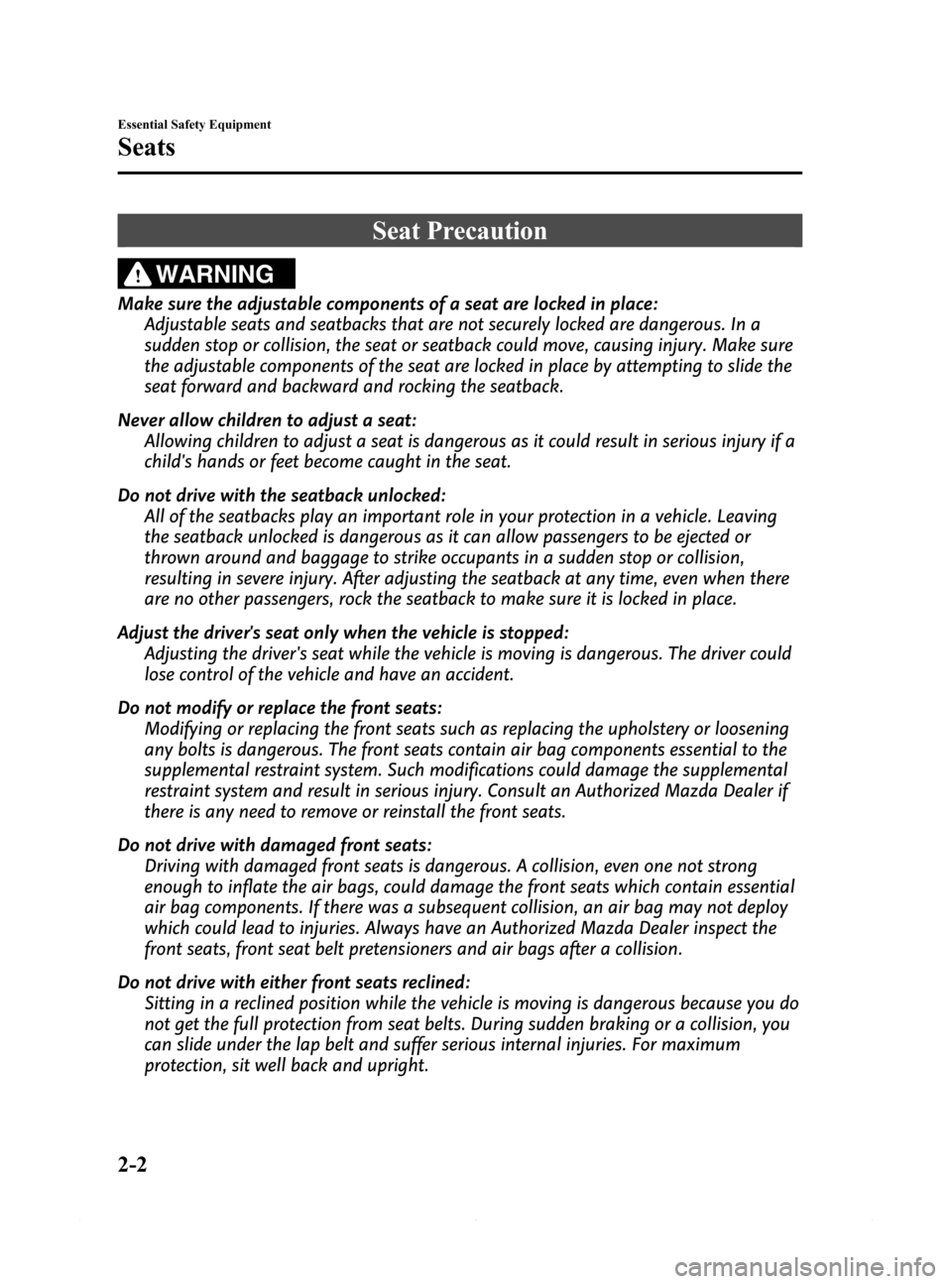
Black plate (14,1)
Seat Precaution
WARNING
Make sure the adjustable components of a seat are locked in place:
Adjustable seats and seatbacks that are not securely locked are dangerous. In a
sudden stop or collision, the seat or seatback could move, causing injury. Make sure
the adjustable components of the seat are locked in place by attempting to slide the
seat forward and backward and rocking the seatback.
Never allow children to adjust a seat:
Allowing children to adjust a seat is dangerous as it could result in serious injury if a
child's hands or feet become caught in the seat.
Do not drive with the seatback unlocked:
All of the seatbacks play an important role in your protection in a vehicle. Leaving
the seatback unlocked is dangerous as it can allow passengers to be ejected or
thrown around and baggage to strike occupants in a sudden stop or collision,
resulting in severe injury. After adjusting the seatback at any time, even when there
are no other passengers, rock the seatback to make sure it is locked in place.
Adjust the driver's seat only when the vehicle is stopped:
Adjusting the driver's seat while the vehicle is moving is dangerous. The driver could
lose control of the vehicle and have an accident.
Do not modify or replace the front seats:
Modifying or replacing the front seats such as replacing the upholstery or loosening
any bolts is dangerous. The front seats contain air bag components essential to the
supplemental restraint system. Such modifications could damage the supplemental
restraint system and result in serious injury. Consult an Authorized Mazda Dealer if
there is any need to remove or reinstall the front seats.
Do not drive with damaged front seats:
Driving with damaged front seats is dangerous. A collision, even one not strong
enough to inflate the air bags, could damage the front seats which contain essential
air bag components. If there was a subsequent collision, an air bag may not deploy
which could lead to injuries. Always have an Authorized Mazda Dealer inspect the
front seats, front seat belt pretensioners and air bags after a collision.
Do not drive with either front seats reclined:
Sitting in a reclined position while the vehicle is moving is dangerous because you do
not get the full protection from seat belts. During sudden braking or a collision, you
can slide under the lap belt and suffer serious internal injuries. For maximum
protection, sit well back and upright.
2-2
Essential Safety Equipment
Seats
Mazda6_8DQ8-EA-13L_Edition3 Page14
Friday, June 13 2014 6:20 PM
Form No.8DQ8-EA-13L
Page 15 of 576
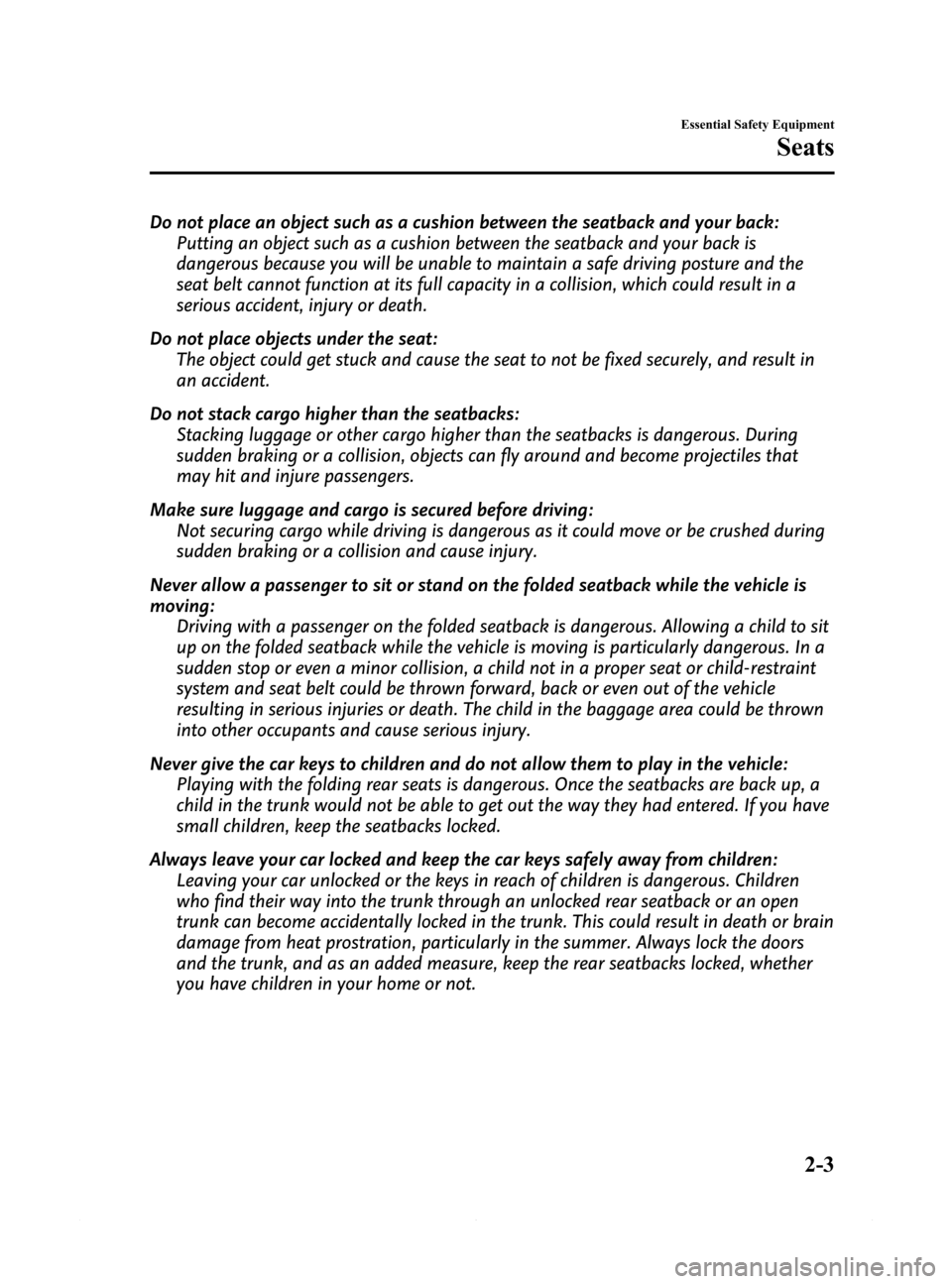
Black plate (15,1)
Do not place an object such as a cushion between the seatback and your back:
Putting an object such as a cushion between the seatback and your back is
dangerous because you will be unable to maintain a safe driving posture and the
seat belt cannot function at its full capacity in a collision, which could result in a
serious accident, injury or death.
Do not place objects under the seat:
The object could get stuck and cause the seat to not be fixed securely, and result in
an accident.
Do not stack cargo higher than the seatbacks:
Stacking luggage or other cargo higher than the seatbacks is dangerous. During
sudden braking or a collision, objects can fly around and become projectiles that
may hit and injure passengers.
Make sure luggage and cargo is secured before driving:
Not securing cargo while driving is dangerous as it could move or be crushed during
sudden braking or a collision and cause injury.
Never allow a passenger to sit or stand on the folded seatback while the vehicle is
moving:
Driving with a passenger on the folded seatback is dangerous. Allowing a child to sit
up on the folded seatback while the vehicle is moving is particularly dangerous. In a
sudden stop or even a minor collision, a child not in a proper seat or child-restraint
system and seat belt could be thrown forward, back or even out of the vehicle
resulting in serious injuries or death. The child in the baggage area could be thrown
into other occupants and cause serious injury.
Never give the car keys to children and do not allow them to play in the vehicle:
Playing with the folding rear seats is dangerous. Once the seatbacks are back up, a
child in the trunk would not be able to get out the way they had entered. If you have
small children, keep the seatbacks locked.
Always leave your car locked and keep the car keys safely away from children:
Leaving your car unlocked or the keys in reach of children is dangerous. Children
who find their way into the trunk through an unlocked rear seatback or an open
trunk can become accidentally locked in the trunk. This could result in death or brain
damage from heat prostration, particularly in the summer. Always lock the doors
and the trunk, and as an added measure, keep the rear seatbacks locked, whether
you have children in your home or not.
Essential Safety Equipment
Seats
2-3
Mazda6_8DQ8-EA-13L_Edition3 Page15
Friday, June 13 2014 6:20 PM
Form No.8DQ8-EA-13L
Page 26 of 576
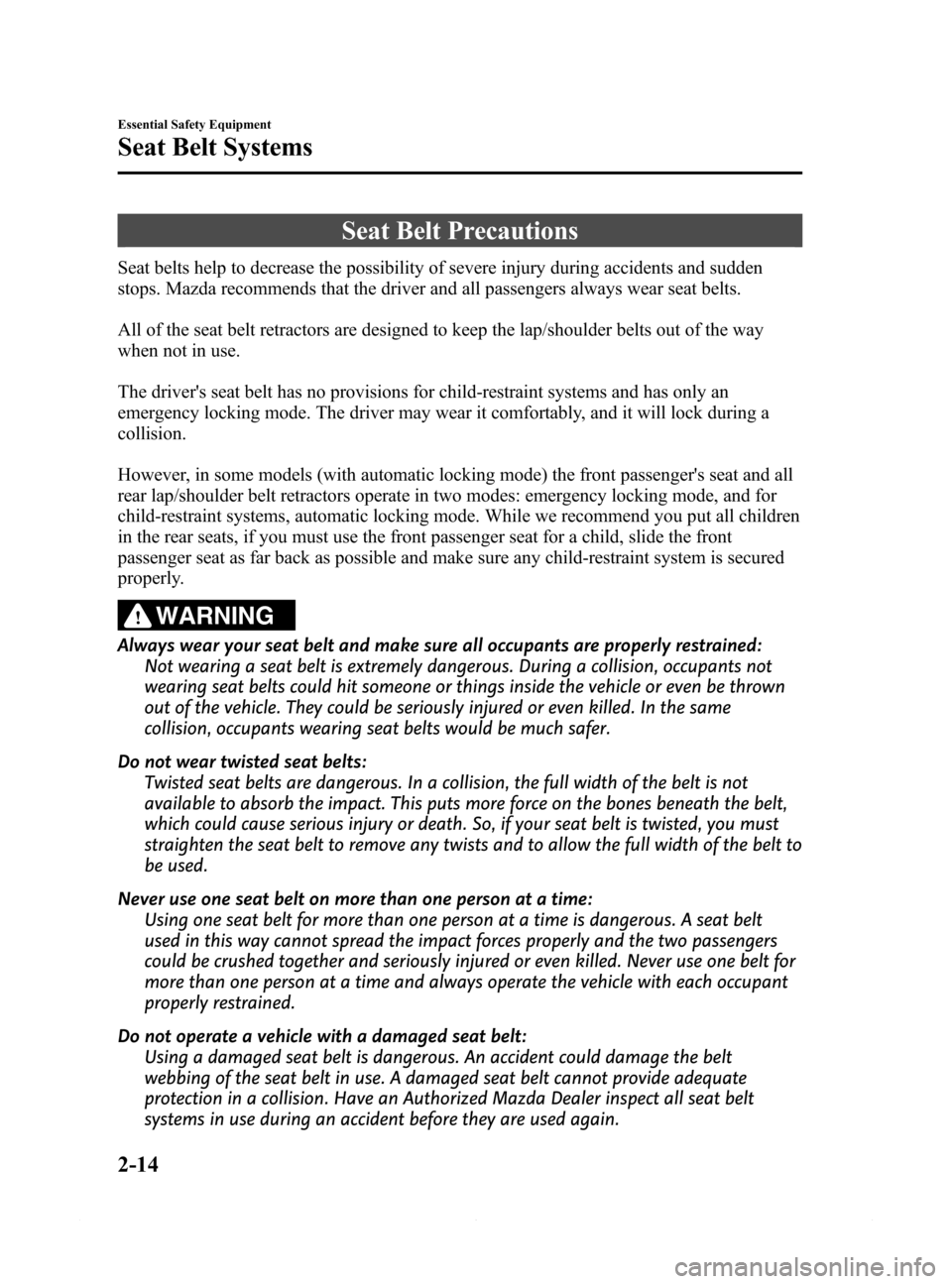
Black plate (26,1)
Seat Belt Precautions
Seat belts help to decrease the possibility of severe injury during accidents and sudden
stops. Mazda recommends that the driver and all passengers always wear seat belts.
All of the seat belt retractors are designed to keep the lap/shoulder belts out of the way
when not in use.
The driver's seat belt has no provisions for child-restraint systems and has only an
emergency locking mode. The driver may wear it comfortably, and it will lock during a
collision.
However, in some models (with automatic locking mode) the front passenger's seat and all
rear lap/shoulder belt retractors operate in two modes: emergency locking mode, and for
child-restraint systems, automatic locking mode. While we recommend you put all children
in the rear seats, if you must use the front passenger seat for a child, slide the front
passenger seat as far back as possible and make sure any child-restraint system is secured
properly.
WARNING
Always wear your seat belt and make sure all occupants are properly restrained:
Not wearing a seat belt is extremely dangerous. During a collision, occupants not
wearing seat belts could hit someone or things inside the vehicle or even be thrown
out of the vehicle. They could be seriously injured or even killed. In the same
collision, occupants wearing seat belts would be much safer.
Do not wear twisted seat belts:
Twisted seat belts are dangerous. In a collision, the full width of the belt is not
available to absorb the impact. This puts more force on the bones beneath the belt,
which could cause serious injury or death. So, if your seat belt is twisted, you must
straighten the seat belt to remove any twists and to allow the full width of the belt to
be used.
Never use one seat belt on more than one person at a time:
Using one seat belt for more than one person at a time is dangerous. A seat belt
used in this way cannot spread the impact forces properly and the two passengers
could be crushed together and seriously injured or even killed. Never use one belt for
more than one person at a time and always operate the vehicle with each occupant
properly restrained.
Do not operate a vehicle with a damaged seat belt:
Using a damaged seat belt is dangerous. An accident could damage the belt
webbing of the seat belt in use. A damaged seat belt cannot provide adequate
protection in a collision. Have an Authorized Mazda Dealer inspect all seat belt
systems in use during an accident before they are used again.
2-14
Essential Safety Equipment
Seat Belt Systems
Mazda6_8DQ8-EA-13L_Edition3 Page26
Friday, June 13 2014 6:20 PM
Form No.8DQ8-EA-13L
Page 28 of 576
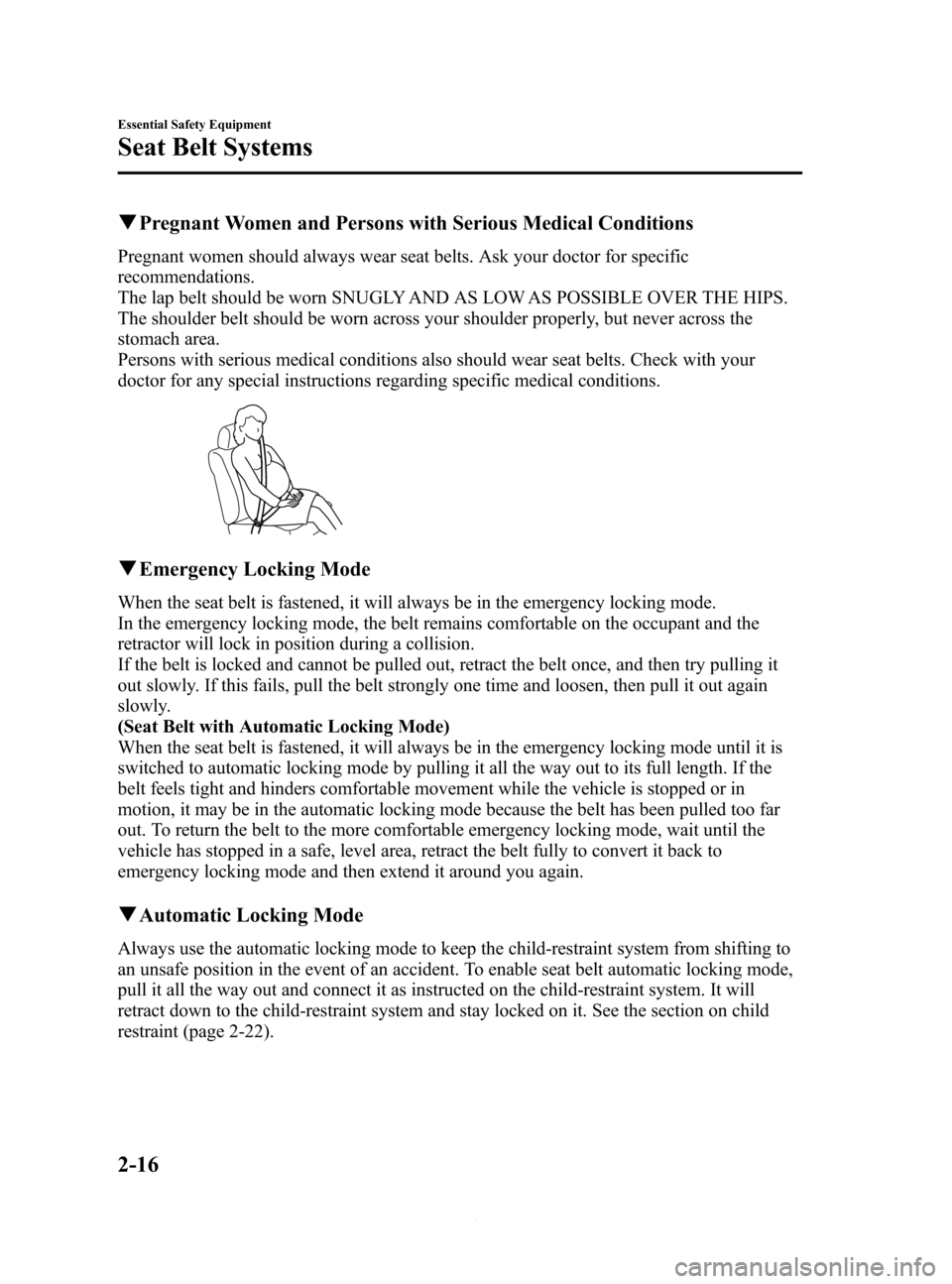
Black plate (28,1)
qPregnant Women and Persons with Serious Medical Conditions
Pregnant women should always wear seat belts. Ask your doctor for specific
recommendations.
The lap belt should be worn SNUGLY AND AS LOW AS POSSIBLE OVER THE HIPS.
The shoulder belt should be worn across your shoulder properly, but never across the
stomach area.
Persons with serious medical conditions also should wear seat belts. Check with your
doctor for any special instructions regarding specific medical conditions.
qEmergency Locking Mode
When the seat belt is fastened, it will always be in the emergency locking mode.
In the emergency locking mode, the belt remains comfortable on the occupant and the
retractor will lock in position during a collision.
If the belt is locked and cannot be pulled out, retract the belt once, and then try pulling it
out slowly. If this fails, pull the belt strongly one time and loosen, then pull it out again
slowly.
(Seat Belt with Automatic Locking Mode)
When the seat belt is fastened, it will always be in the emergency locking mode until it is
switched to automatic locking mode by pulling it all the way out to its full length. If the
belt feels tight and hinders comfortable movement while the vehicle is stopped or in
motion, it may be in the automatic locking mode because the belt has been pulled too far
out. To return the belt to the more comfortable emergency locking mode, wait until the
vehicle has stopped in a safe, level area, retract the belt fully to convert it back to
emergency locking mode and then extend it around you again.
qAutomatic Locking Mode
Always use the automatic locking mode to keep the child-restraint system from shifting to
an unsafe position in the event of an accident. To enable seat belt automatic locking mode,
pull it all the way out and connect it as instructed on the child-restraint system. It will
retract down to the child-restraint system and stay locked on it. See the section on child
restraint (page 2-22).
2-16
Essential Safety Equipment
Seat Belt Systems
Mazda6_8DQ8-EA-13L_Edition3 Page28
Friday, June 13 2014 6:20 PM
Form No.8DQ8-EA-13L
Page 37 of 576

Black plate (37,1)
Seating a child in a child-restraint system on the front passenger seat is dangerous
under certain conditions (With Front Passenger Occupant Classification System):
Your vehicle is equipped with front passenger seat weight sensors. Even with the
front passenger seat weight sensors, if you must use the front passenger seat to seat
a child, using a child-restraint system on the front passenger seat under the
following conditions increases the danger of the front passenger air bag deploying
and could result in serious injury or death to the child.
ØThe front passenger air bag deactivation indicator light does not illuminate when
seating a child in the child-restraint system.
ØLuggage or other items are placed on the seat with the child in the child-restraint
system.
ØA rear passenger or luggage pushing or pulling down on the front passenger
seatback.
ØA rear passenger puts their feet on the front seat rails.
ØLuggage or other items are placed on the seatback or hung on the head restraint.
ØHeavy items are placed in the seatback map pocket.
ØThe seat is washed.
ØLiquids are spilled on the seat.
ØThe front passenger seat is moved backward, pushing into luggage or other items
placed behind it.
ØThe front passenger seatback contacts the rear seat.
ØLuggage or other items are placed between the front passenger seat and driver
seat.
ØAny accessories, which might increase the total seated weight on the front
passenger seat, are attached to the front passenger seat.
The designated positions with seat belts on the rear seats are the safest places for
children. Always use seat belts and child restraints.
Do not allow a child or anyone to lean over or against the side window of a vehicle
with side and curtain air bags:
It is dangerous to allow anyone to lean over or against the side window, the area of
the front passenger seat, the front and rear window pillars and the roof edge along
both sides from which the side and curtain air bags deploy, even if a child-restraint
system is used. The impact of inflation from a side or curtain air bag could cause
serious injury or death to an out of position child. Furthermore, leaning over or
against the front door could block the side and curtain air bags and eliminate the
advantages of supplemental protection. With the front air bag and the additional
side air bag that comes out of the front seat, the rear seat is always a better location
for children. Take special care not to allow a child to lean over or against the side
window, even if the child is seated in a child-restraint system.
Essential Safety Equipment
Child Restraint
2-25
Mazda6_8DQ8-EA-13L_Edition3 Page37
Friday, June 13 2014 6:20 PM
Form No.8DQ8-EA-13L
Page 42 of 576

Black plate (42,1)
qUsing Automatic Locking Mode
Follow these instructions when using a
child-restraint system, unless you are
attaching a LATCH-equipped child-
restraint system to the rear LATCH lower
anchors. Refer to“Using LATCH Lower
Anchor”(page 2-35).
NOTE
Follow the child-restraint system
manufacturer's instructions carefully. If you
are not sure whether you have a LATCH
system or tether, check in the child-restraint
system manufacturer's instructions and follow
them accordingly. Depending on the type of
child-restraint system, it may use LATCH
system instead of seat belts or if the belt goes
across the child's chest, may recommend
against using automatic locking mode.
1. Make sure the seatback is securely
latched by pushing it back until it is
fully locked.
2. Raise the head restraint to the top
locked position.
Refer to Head Restraints on page 2-12.
3. Secure the child-restraint system with
the lap portion of the lap/shoulder belt.
See the manufacturer's instructions on
the child-restraint system for belt
routing instructions.4. To get the retractor into the automatic
locking mode, pull the shoulder belt
portion of the seat belt until the entire
length of the belt is out of the retractor.
5. Push the child-restraint system firmly
into the vehicle seat. Be sure the belt
retracts as snugly as possible. A
clicking noise from the retractor will be
heard during retraction if the system is
in the automatic locking mode. If the
belt does not lock the seat down tight,
repeat this step.
2-30
Essential Safety Equipment
Child Restraint
Mazda6_8DQ8-EA-13L_Edition3 Page42
Friday, June 13 2014 6:20 PM
Form No.8DQ8-EA-13L
Page 43 of 576

Black plate (43,1)
NOTE
Inspect this function before each use of the
child-restraint system. You should not be able
to pull the shoulder belt out of the retractor
while the system is in the automatic locking
mode. When you remove the child-restraint
system, be sure the belt fully retracts to return
the system to emergency locking mode before
occupants use the seat belts.
6. If your child-restraint system requires
the use of a tether strap, refer to the
manufacturer's instructions to hook and
tighten the tether strap.
WARNING
Use the tether and tether anchor only
for a child-restraint system:
Using the tether or tether anchor to
secure anything but a child-restraint
system is dangerous. This could
weaken or damage the tether or
tether anchor and result in injury.Always route the tether strap between
the head restraint and the seatback:
Routing the tether strap on top of the
head restraint is dangerous. In a
collision the tether strap could slide
off the head restraint and loosen the
child-restraint system. The child-
restraint system could move which
may result in death or injury to the
child.
Anchor bracket
Tether strap
Anchor bracket
Tether strap
Always attach the tether strap to the
correct tether anchor position:
Attaching the tether strap to the
incorrect tether anchor position is
dangerous. In a collision, the tether
strap could come off and loosen the
child-restraint system. If the child-
restraint system moves it could result
in death or injury to the child.
Essential Safety Equipment
Child Restraint
2-31
Mazda6_8DQ8-EA-13L_Edition3 Page43
Friday, June 13 2014 6:20 PM
Form No.8DQ8-EA-13L
Page 45 of 576

Black plate (45,1)
Do not allow a child or anyone to lean
over or against the side window of a
vehicle with side and curtain air bags:
It is dangerous to allow anyone to
lean over or against the side window,
the area of the front passenger seat,
the front and rear window pillars and
the roof edge along both sides from
which the side and curtain air bags
deploy, even if a child-restraint
system is used. The impact of
inflation from a side or curtain air
bag could cause serious injury or
death to an out of position child.
Furthermore, leaning over or against
the front door could block the side
and curtain air bags and eliminate
the advantages of supplemental
protection. With the front air bag and
the additional side air bag that
comes out of the front seat, the rear
seat is always a better location for
children. Take special care not to
allow a child to lean over or against
the side window, even if the child is
seated in a child-restraint system.
Front Passenger's Seat Child-Restraint
System Installation (With automatic
locking mode seat belt)
1. Switch the ignition ON.2. Slide the seat as far back as possible.
3. Place the child-restraint system on the
seat without putting your weight on the
seat and fasten the seat belt. See the
manufacturer's instructions on the
child-restraint system for belt routing
instructions.
4. To get the retractor into the automatic
locking mode, pull the shoulder belt
portion of the seat belt until the entire
length of the belt is out of the retractor.
5. Push the child-restraint system firmly
into the vehicle seat. Be sure the belt
retracts as snugly as possible. A
clicking noise from the retractor will be
heard during retraction if the system is
in automatic locking mode. If the belt
does not lock the seat down tight,
repeat the previous step and also this
one.
Essential Safety Equipment
Child Restraint
2-33
Mazda6_8DQ8-EA-13L_Edition3 Page45
Friday, June 13 2014 6:20 PM
Form No.8DQ8-EA-13L
Page 46 of 576
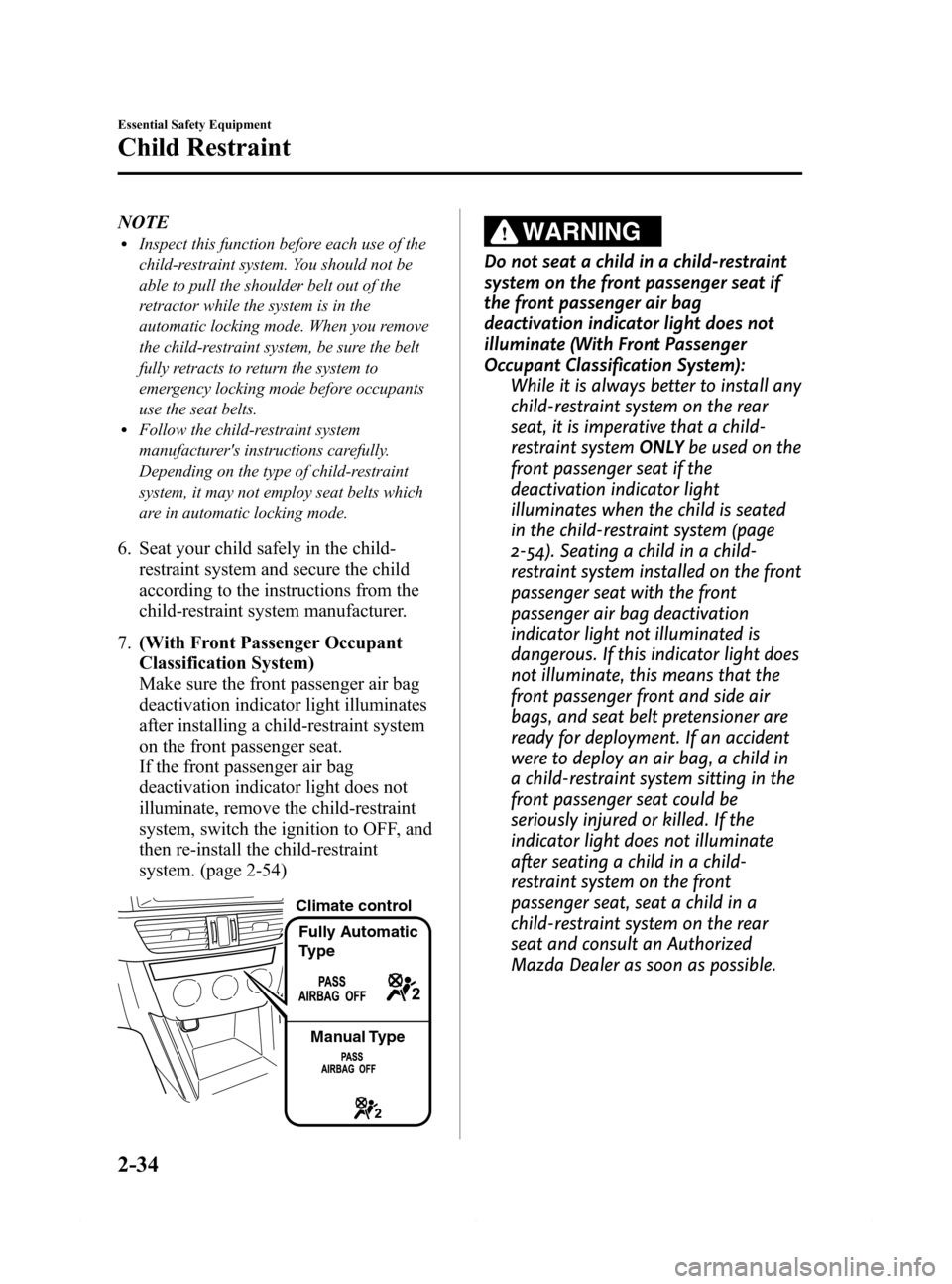
Black plate (46,1)
NOTElInspect this function before each use of the
child-restraint system. You should not be
able to pull the shoulder belt out of the
retractor while the system is in the
automatic locking mode. When you remove
the child-restraint system, be sure the belt
fully retracts to return the system to
emergency locking mode before occupants
use the seat belts.
lFollow the child-restraint system
manufacturer's instructions carefully.
Depending on the type of child-restraint
system, it may not employ seat belts which
are in automatic locking mode.
6. Seat your child safely in the child-
restraint system and secure the child
according to the instructions from the
child-restraint system manufacturer.
7.(With Front Passenger Occupant
Classification System)
Make sure the front passenger air bag
deactivation indicator light illuminates
after installing a child-restraint system
on the front passenger seat.
If the front passenger air bag
deactivation indicator light does not
illuminate, remove the child-restraint
system, switch the ignition to OFF, and
then re-install the child-restraint
system. (page 2-54)
Climate control
Fully Automatic
Type
Manual Type
WARNING
Do not seat a child in a child-restraint
system on the front passenger seat if
the front passenger air bag
deactivation indicator light does not
illuminate (With Front Passenger
Occupant Classification System):
While it is always better to install any
child-restraint system on the rear
seat, it is imperative that a child-
restraint systemONLYbe used on the
front passenger seat if the
deactivation indicator light
illuminates when the child is seated
in the child-restraint system (page
2-54). Seating a child in a child-
restraint system installed on the front
passenger seat with the front
passenger air bag deactivation
indicator light not illuminated is
dangerous. If this indicator light does
not illuminate, this means that the
front passenger front and side air
bags, and seat belt pretensioner are
ready for deployment. If an accident
were to deploy an air bag, a child in
a child-restraint system sitting in the
front passenger seat could be
seriously injured or killed. If the
indicator light does not illuminate
after seating a child in a child-
restraint system on the front
passenger seat, seat a child in a
child-restraint system on the rear
seat and consult an Authorized
Mazda Dealer as soon as possible.
2-34
Essential Safety Equipment
Child Restraint
Mazda6_8DQ8-EA-13L_Edition3 Page46
Friday, June 13 2014 6:20 PM
Form No.8DQ8-EA-13L